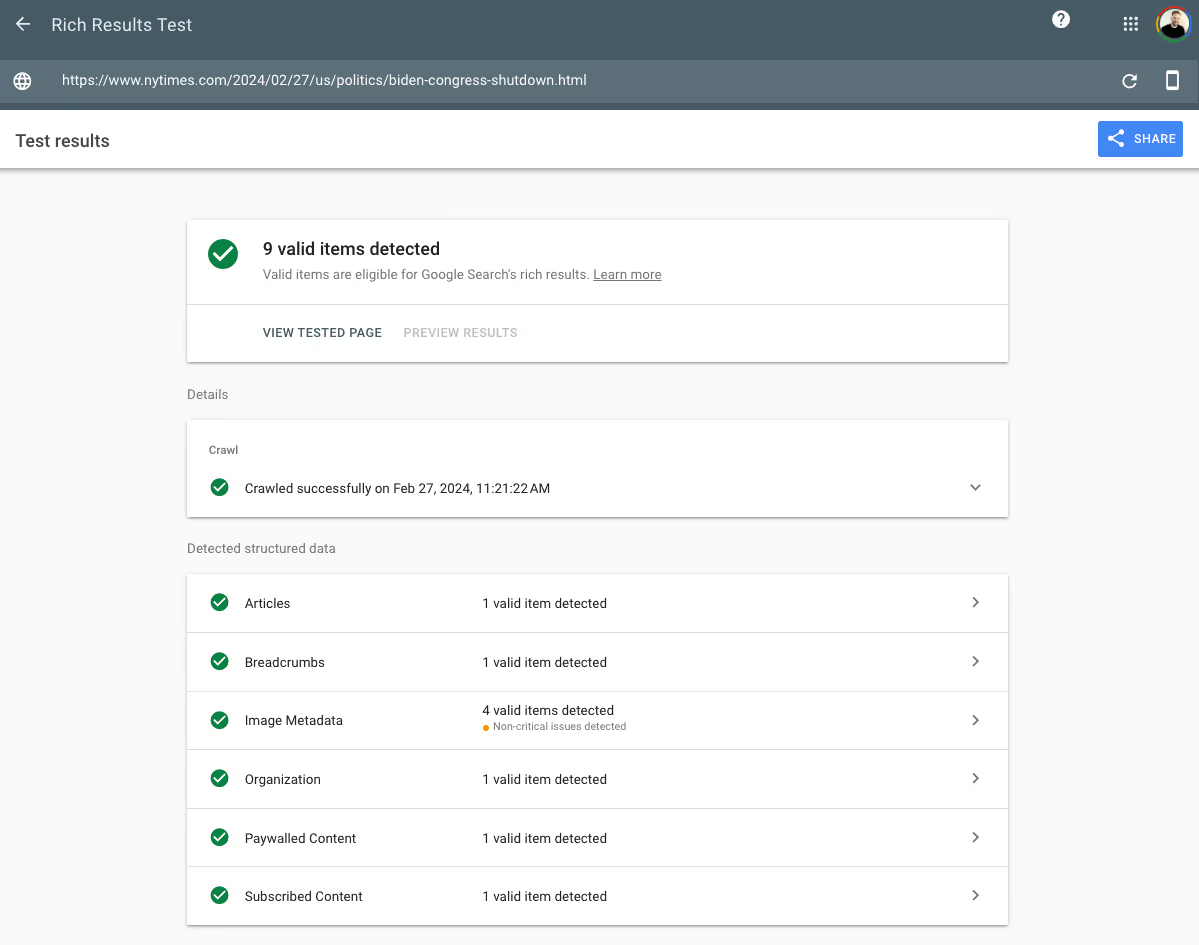In the past few years, Google has consistently emphasized the importance of trustworthiness and authority in its search rankings. These factors, collectively known as E-E-A-T (Experience, Expertise, Authoritativeness, Trustworthiness), are an important part of Google's Search Quality Evaluator Guidelines used to help human raters assess the quality of search results manually.
While Google is not completely transparent about the exact workings of its ranking algorithm, there is consensus among SEO (Search Engine Optimization) experts that trustworthiness is a critical factor. From a practical perspective, this makes sense as well. People are more likely to trust information from credible first-hand sources like scientists than they are from anonymous writers on the internet, so content created by trustworthy individuals should probably receive a rankings boost.
Finally, the increase in AI-generated content only bolsters the value of having real, knowledgeable experts contribute content to your site. Generative AI models are powerful but prone to hallucinations and need to be checked by subject matter experts if you want to use them well.
So, if you want to ensure your content has the best chance of ranking well in search engines, having credible authors on your site is an important factor. And, if you want Google to recognize the authors you’re using on your site, you need to feed it that information in a structured way.
That’s where Author Schema comes in.
Understanding Author Schema Markup
Author Schema Markup provides a standard way to add author data to any web page so that search engines and web crawlers can understand the page’s author and their credentials. It’s built on Schema.org’s definition and can be embedded via JSON or HTML properties into your website.
For non-technical SEOs, all that means is that by including author metadata in the correct format on each page of your site, you can improve the likelihood that Google will recognize the authority of that page and increase its chances of ranking highly in search results.
While I will show you specific code samples in this piece, you don’t have to be a web developer to understand author schema, and many tools exist to help you implement it without code. By the end of this article, you should understand what author schema is, the markup used to define it, how to implement it yourself, and some best practices for using it and keeping it up to date.
Author Schema and Google Search Results
When properly added to your website, Author Schema data can help Google create rich snippets that highlight an author’s biographical, social media, and work information. For example, when you search for “David Goggins,” a well-known author and endurance athlete, you’ll see a summary of information about him to the right of the results. Google has gathered this data from his personal website, at least partially from Author Schema Markdown.

Similarly, results for “Tim Ferriss,” an author and entrepreneur, show photos, information from his website, and social media profiles.

While Google doesn’t create these rich snippets for every writer on the internet, giving Google the structured information in the form of Author Schema Markdown ensures that the data is available to them. Behind the scenes, Google collects this data on many authors across the internet and uses it to improve its understanding of each writer’s quality, credibility, and popularity to improve search results in the future.
Benefits of Implementing Author Schema Data
There are other benefits to using Author Schema Data in your website beyond just giving authors a fancy bio page in Google results. Let’s take a look at a few of these and how they impact your website’s usability and visibility in search results:
1. Enhanced Search Engine Understanding
Author Schema Markup helps search engines understand not just the content but the context and authority behind each blog post or piece of content on your site. This is particularly important for topics requiring expertise and trustworthiness (i.e., health, law, finance, or technical knowledge). By identifying the author, search engines can evaluate the content's credibility based on the author's reputation and expertise.
2. Improved Content Trustworthiness
For websites covering specialized or niche topics, showcasing the expertise of the author can significantly boost the perceived trustworthiness and quality of the content. This means including a visible bio for the author as well as embedding the Markup for search engines.

3. Potential for Higher Search Result Click-Through Rates (CTR)
While Google's Authorship program has ended, structured data, including Author Schema, can still contribute to rich snippets and enhanced search listings. These enhanced listings can make search results more eye-catching, potentially increasing CTR.
4. Social Media Connection
Author Schema can include social media links, helping tie an author's contributions to their social media presence. This enhances the author's overall visibility and authority and also allows readers to follow or reach out to authors they like.
5. Future-Proofing Content
Finally, search engines are evolving all the time, and the emphasis on context, authority, and trustworthiness of content will only increase in the coming years. Implementing structured data like Author Schema Markup ensures that your content can continue to benefit from changes that search engines use to evaluate and rank content as AI-generated content becomes more prolific.
Using and Implementing Author Schema Markup
Both website owners and authors benefit from properly implemented Author Schema Markup, so let’s take a look at how it works and how you can use it in your website.
How Author Schema Markup Works
From a technical perspective, web crawlers (like Google’s) can more easily understand structured data that matches a predetermined pattern than unstructured data on a web page. In other words, while Google might be able to figure out the author of a web page from content within the page, it can determine it much more easily if the page uses Author Schema Markup.
This markup can be included as JSON in the <head> of your web page’s HTML (which Google recommends), inline Microdata, or linked data in RDFa. While all three methods are based on the Schema.org author definition, each implementation is slightly different.
Implementing Author Schema Markup Manually
First, let’s take a look at implementing JSON-LD Author Schema metadata. By adding this data inside a <script> tag in the <head> of the HTML document that renders the blog post, search engines, and crawlers will be able to gather the post’s metadata, including the Author Schema:
In this example, the structured data snippet provides the article title (headline), a brief description (description), an image associated with the article (image), information about the author (author) including their job title within the organization, the publishing organization (publisher), and the publication dates. It also specifies the URL of the web page where the article is published (mainEntityOfPage).
Alternatively, you can add this metadata to the HTML <body> within your blog post. This allows you to make the Author and Article Schema data visible if you want, but it’s a little more difficult to find as it’s embedded in the actual content of your HTML file:
You can learn more about all the metadata properties and implementation options available in Google’s documentation.
Tools and Resources for Implementing Author Schema
While adding a few lines of JSON to the top of a single HTML file or a few properties to HTML tags is relatively easy, in real life, you’ll want to generate this markup automatically. This allows you to dynamically include it for each author on each page of your site, even if you have thousands of pages of content.
Depending on your CMS and the technical limitations of your website, there are several tools that can help you implement Author and Article Schema Markup automatically. Let’s take a look at a few that work for the most popular content management systems.
1. WordPress
WordPress is one of the world’s most popular content management systems, so there’s a good chance your blog runs on it. Because it’s so popular, there are also many good plugins that allow you to generate Author Schema Markup and include it on each page:
- Yoast SEO - Beyond its comprehensive SEO features, Yoast SEO offers structured data support, including the ability to easily add and configure Article and Author Schema. It simplifies the process, making it accessible even for those without technical expertise.
- Schema Pro - This plugin is dedicated to helping you add schema markup to your WordPress site. It supports a wide array of schema types, including those for authors and articles, and allows for quick setup with minimal fuss.
- Rank Math SEO - Rank Math provides an easy-to-use interface for managing SEO, including support for schema markup. It automatically generates Article Schema and allows for the customization of the Author Schema, ensuring that your content is properly marked up for search engines.
2. Drupal
For those using Drupal, the platform offers a couple of modules that facilitate the addition of structured data:
- Schema.org Metatag - This module allows for the easy addition of Schema.org structured data to Drupal content. It supports a wide range of schema types and provides a user interface for adding and customizing Schema data for Authors and Articles among other content types.
- RDF UI - Building on Drupal's RDF capabilities, this module offers more advanced users the ability to map site content to RDFa data. This can be particularly useful for custom content types and complex sites.
3. Joomla
Joomla offers a nice middle ground between the user-friendliness of WordPress and the complexity of Drupal. It also provides some tools that can automate the addition of Author Schema Markup to websites with extensions designed for SEO and structured data:
- Google Structured Data - This extension makes it easy to add various types of schema markup to your Joomla site, including Author and Article Schema. It integrates seamlessly with Joomla articles and custom content types, providing a straightforward way to enhance your content's visibility.
- JoomSEF - While primarily focused on creating search engine-friendly URLs, JoomSEF also offers support for structured data, helping you ensure that your author data is optimized for crawlers.
4. Custom Code
Finally, if your website wasn’t built with an off-the-shelf CMS, you’ll probably need to enlist the help of your web development team to add Author Schema Markup. In this case, you should create several examples for them to help them understand the structure of the data to be included on each page. You should also instruct them on handling edge cases, like when data is missing from a page or the author is undefined.
Once implemented, spot-check a few pages to ensure that the data looks right. In the Google Chrome browser, you can do this by right-clicking on a web page and selecting “View Page Source”.

Then, search for the application/ld+json script tag or itemprops as shown in the examples above.
Best Practices for Implementing Author Schema Markup
If you use a tool or have an experienced software development team at your disposal, implementing Author Schema Markup may look simple, but it’s easy to make a small mistake that ends up breaking the entire schema. Here are a few things you can do to ensure you stay compliant and that you’re getting the most from your efforts:
1. Check Your Rich Results
Use Google’s free test to see whether Google is indexing your structured data.

If not, you may have errors in Google Search Console, so be sure to check for more details.
2. Keep Your Schema Updated
Schema.org regularly updates its vocabulary to include new item types and properties or to adjust existing ones. Make sure to keep your markup up to date with these changes. Regularly reviewing and updating your markup can enhance how your content is understood and displayed by search engines, leading to better visibility and click-through rates.
3. Include Every Author Property You Can
Make sure to include all essential properties when creating your schema markup. For an author, this typically includes their name, but you can also add properties like jobTitle, affiliation, and image. Including these will make your structured data more informative and compelling to both search engines and users.
4. Integrate Social Media Links
Including links to the author's social media profiles using the sameAsproperty can enrich the Author Schema Markup. This helps establish credibility and authority as well as allows search engines to create a more comprehensive profile of the author.
For more technical best practices and some common troubleshooting methods, check out Google’s documentation here.
Final Thoughts
Author Schema Markup is an important tool for content marketing teams as it enhances trust, visibility, credibility, and engagement in search results. By properly implementing it, publishers can provide search engines with rich, contextual information about their authors and pave the way for more personalized and authoritative search experiences in the future.
As generative AI makes creating low-authority content easier and easier, search engines will continue to emphasize high-quality content and creators with authority in specific subjects. This means that Author Schema and similar tools will only be more important for SEO teams in the years ahead.
Finally, if you’re trying to stay on top of how your site appears in search engines and maximize the value of your content marketing efforts, check out Positional. Their suite of tools can help you plan, optimize, and track your content’s effectiveness, so book a demo today.
.avif)




